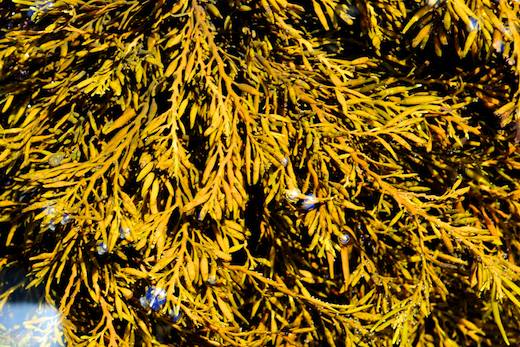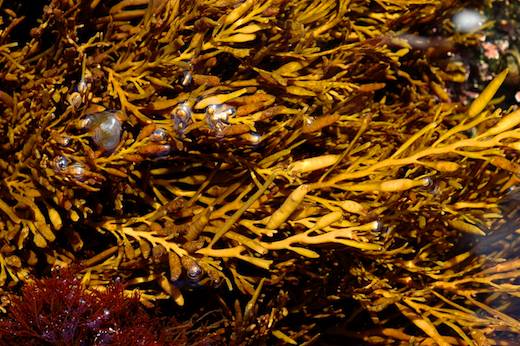Halidrys siliquosa (Linnaeus) Lyngbye

Common names: Pod-weed. Sea Oak (English). Crúba Préacháin, Fraoch Freangach,Rupán (Irish).
Description: Thallus 30-130 cm long, tawney to yellow-brown ochre, tough and leathery; attached by a large, discoid holdfast, giving rise to compressed, irregularly alternately branched fronds, with several orders of close branching in the same plane. Pod-shaped, segmented, air bladders, are produced replacing some lateral branches. Reproductive conceptacles forming in swollen conceptacles at the apices of the branches (below).
Habitat: Found most commonly in large, mid-intertidal pools, often dominating in the very large, sunny pools, but more often forming occasional stands. Occasionally forming extensive forests in the shallow subtidal to about 10 m, generally in current-exposed situations. Widespread and common.
Similar species: Sargassum muticum, which has single, teardrop-shaped bladders that are not segmented, and is branched spirally in more than one plane. Cystoseira species, which are generally more or less terete and branched in more than one plane. Bifurcaria bifurcata, which occupied the same habitat, but is regularly dichotomously branched, cylindrical and arises from branched rhizoids; it also occurs only rarely (south-west Britain, western Ireland, mainly on limestone shores).
Key characteristics: alternate branching, segmented pod-like air-bladders.
Ecology: Halidrys produces meroditerpenoids that seemingly act as antifouling agents preventing other organisms adhering to the surface of the plant. The large brown pom-poms of Sphacelaria cirrosa, another brown alga, occur frequently on larger plants. Halidrys also regularly sheds the upper epidermal layer to rid itself of surface organisms; Sphacelaria manages to penetrate beyond this layer allowing it to remain in place.

Photographs © M.D. Guiry





